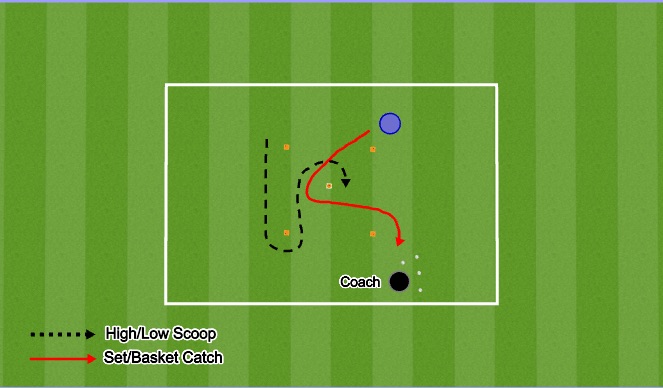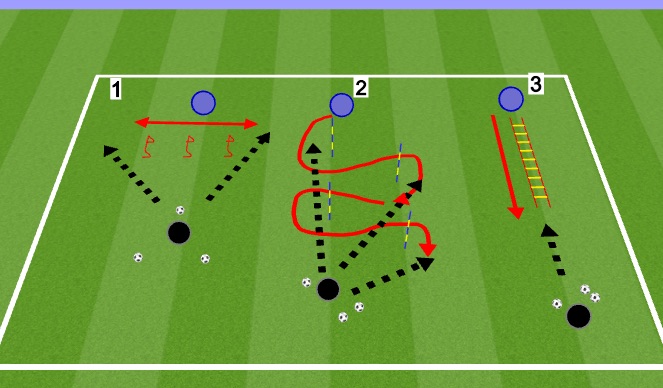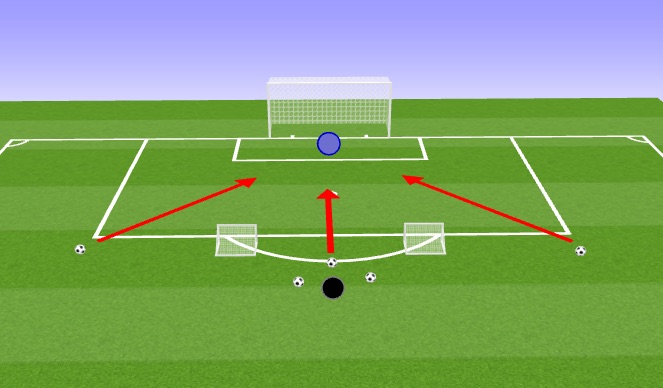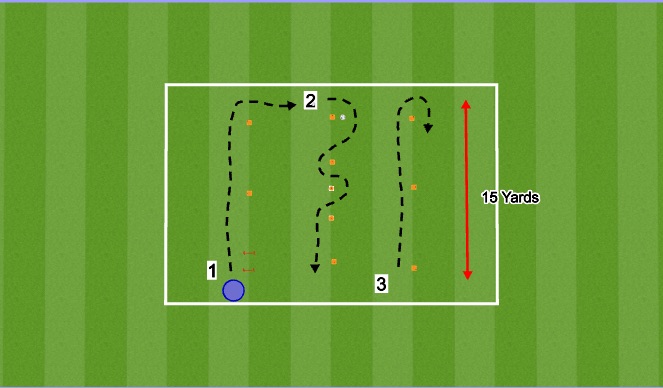Football/Soccer Session (Beginner): Summer workout plan - W4 handling

Profile Summary

| Name: | Steven Corcoran |
|---|---|
| City: | Stamford |
| Country: | United States of America |
| Membership: | Adult Member |
| Sport: | Football/Soccer |

See the guidance at the top of this page to understand why you are not seeing interactive Football/Soccer images.

Handling 1 (15 mins)
Organization
Set up as shown in the diagram
Cones 2 yards apart
The player completes 10 catches on each side (all 4 sets)
Coaching Points
Set Catch Head and eyes should be focused on the ball. Arms extended above but slightly in front of the head/chest. Hands should make a “W” shape, soft fingers around the contour of the ball, hands are held even with fingers spread to receive the ball. Once the ball is caught, it should be drawn smoothly back into the chest. The keeper’s intentions to win the ball should be clearly communicated with fellow defenders in the form of a loud, commanding and early keeper call.
Basket Catch
Get the body directly in line with the flight of the ball. Feet shoulder-width apart, knees
slightly bent, body weight forward. Head held steady, eyes focused on the ball.
Body bends forward from the waist. Arms extended out towards the ball with
bend in the elbows. Forearms are parallel with the elbows tucked in. Palms of the hands face
upward. Once the ball contacts the hands/forearms it will be cushioned into the pocket created
by the chest/stomach and hands/forearms.
Upon impact the body will relax slightly by getting slightly on the balls of your feet to absorb the impact of the ball. Body should always be facing the ball.
Low Scoop
Get the body directly in line with the flight of the ball, one leg bent. Kneeling reduces
the margin of error by eliminating the gap between the legs, but knee not touching the ground to allow for mobility. Hands are extended forward at ground level. Palms are facing outward waiting to channel the ball safely into the chest. This also allows us as goalkeepers to set up a counter attack.
If the ball is played to the right, then lead with the right foot. If the ball is played to left, then lead with the left foot.
High Catch
Head and eyes should be focused on the ball, ignore other players. Arms extended
And the ball should be caught at the highest point. Hands should make a “W” shape, soft fingers around the contour of the ball, hands are held even with finger’s spread to receive the ball. The keeper should explode into the air with one need raised at a 90 degree angle in order to protect themselves. Once the ball is caught, it should be drawn smoothly back into the chest. The keeper’s intentions to win the ball should be clearly communicated with fellow defenders in the form of a loud, commanding and early keeper call.
Factors to consider
The distance from which the ball is traveling.
The pace of the ball.
Presence of opposition strikers.
The weather conditions

See the guidance at the top of this page to understand why you are not seeing interactive Football/Soccer images.

Handling 2 (15 mins)
Organization
Set up as shown
Set 1 - Player moves laterally and makes a catch at each end of the hurdles
Set 2 - Player moves from side to side making a catch each time they step outside the poles
Set 3 - Player performs different types of footwork and makes a catch at the end of the ladder
10 catches per set x4 (10 set catches, 10 basket catches, 10 low scoops, 10 high catches)
Coaching Points
Maintain good mechanics – on balls of feet, arm, and leg actions.
Set Catch Head and eyes should be focused on the ball. Arms extended above but slightly in front of the head/chest. Hands should make a “W” shape, soft fingers around the contour of the ball, hands are held even with fingers spread to receive the ball. Once the ball is caught, it should be drawn smoothly back into the chest. The keeper’s intentions to win the ball should be clearly communicated with fellow defenders in the form of a loud, commanding and early keeper call.
Basket Catch
Get the body directly in line with the flight of the ball. Feet shoulder-width apart, knees
slightly bent, body weight forward. Head held steady, eyes focused on the ball.
Body bends forward from the waist. Arms extended out towards the ball with
bend in the elbows. Forearms are parallel with the elbows tucked in. Palms of the hands face
upward. Once the ball contacts the hands/forearms it will be cushioned into the pocket created
by the chest/stomach and hands/forearms.
Upon impact the body will relax slightly by getting slightly on the balls of your feet to absorb the impact of the ball. Body should always be facing the ball.
Low Scoop
Get the body directly in line with the flight of the ball, one leg bent. Kneeling reduces
the margin of error by eliminating the gap between the legs, but knee not touching the ground to allow for mobility. Hands are extended forward at ground level. Palms are facing outward waiting to channel the ball safely into the chest. This also allows us as goalkeepers to set up a counter attack.
If the ball is played to the right, then lead with the right foot. If the ball is played to left, then lead with the left foot.
High Catch
Head and eyes should be focused on the ball, ignore other players. Arms extended
And the ball should be caught at the highest point. Hands should make a “W” shape, soft fingers around the contour of the ball, hands are held even with finger’s spread to receive the ball. The keeper should explode into the air with one need raised at a 90 degree angle in order to protect themselves. Once the ball is caught, it should be drawn smoothly back into the chest. The keeper’s intentions to win the ball should be clearly communicated with fellow defenders in the form of a loud, commanding and early keeper call.

See the guidance at the top of this page to understand why you are not seeing interactive Football/Soccer images.

Handling 3 (15 mins)
Organization
5 Ball set up at 3 different angles outside of the 18-yard box (around 20 yards) with 2 mini goals or targets at the top of the box. After making the save the player should feed the ball into the mini goals/targets.
The player should take 5 shots from each angle and go through each type of catch - 3 sets
Coaching Points
Get in line with the flight of the ball.
Set yourself depending on the type of catch you are going to make
Set Catch
Head and eyes should be focused on the ball. Arms extended above but slightly in front of the head/chest. Hands should make a “W” shape, soft fingers around the contour of the ball, hands are held even with finger’s spread to receive the ball. Once the ball is caught, it should be drawn smoothly back into the chest. The keeper’s intentions to win the ball should be clearly communicated with fellow defenders in the form of a loud, commanding and early keeper call.
Factors to consider
The distance from which the ball is traveling.
The pace of the ball.
Presence of opposition strikers.
The weather conditions
Basket Catch
Get the body directly in line with the flight of the ball. Feet shoulder-width apart, knees
slightly bent, body weight forward. Head held steady, eyes focused on the ball.
Body bends forward from the waist. Arms extended out towards the ball with
bend in the elbows. Forearms are parallel with the elbows tucked in. Palms of the hands face
upward. Once the ball contacts the hands/forearms it will be cushioned into the pocket created
by the chest/stomach and hands/forearms.
Upon impact the body will relax slightly by getting slightly on the balls of your feet to absorb the impact of the ball. Body should always be facing the ball.
Low Scoop/Ground Catch
Get the body directly in line with the flight of the ball, one leg bent. Kneeling reduces
the margin of error by eliminating the gap between the legs, but the knee not touching the ground to allow for mobility. Hands are extended forward at ground level. Palms are facing outward waiting to channel the ball safely into the chest. This also allows us as goalkeepers to set up a counterattack.
If the ball is played to the right, then lead with the right foot. If the ball is played to left, then lead with the left foot.
High Catch
Head and eyes should be focused on the ball, ignore other players. Arms extended
And the ball should be caught at the highest point. Hands should make a “W” shape, soft fingers around the contour of the ball, hands are held even with finger’s spread to receive the ball. The keeper should explode into the air with one need raised at a 90 degree angle in order to protect themselves. Once the ball is caught, it should be drawn smoothly back into the chest. The keeper’s intentions to win the ball should be clearly communicated with fellow defenders in the form of a loud, commanding and early keeper call.









 Play animation
Play animation Play step-by-step
Play step-by-step Repeat (toggle)
Repeat (toggle) Full Screen
Full Screen Pause
Pause Stop
Stop
Warm up (10 mins)
Organization
Set up as shown in the diagram
Set 1 through 2 hurdles, pick up the ball, set 2 shuffle between cones, set 3 dynamic exercise.
Each exercise twice
Arms forward /Arms backward
High knees/Butt kicks
Straight kicks/across-body kicks
Open gates/ Close gates
2 shuffle left/ 2 shuffles right
Back peddle halfway/sprint halfway
Full Sprint/full back peddle
Jog halfway, back peddle, full sprint
Coaching Points
The tempo of the activity, slow to fast.
Range of movement.
Maintain good mechanics – on balls of feet, arm, and leg actions.
Interval Duration
10mins